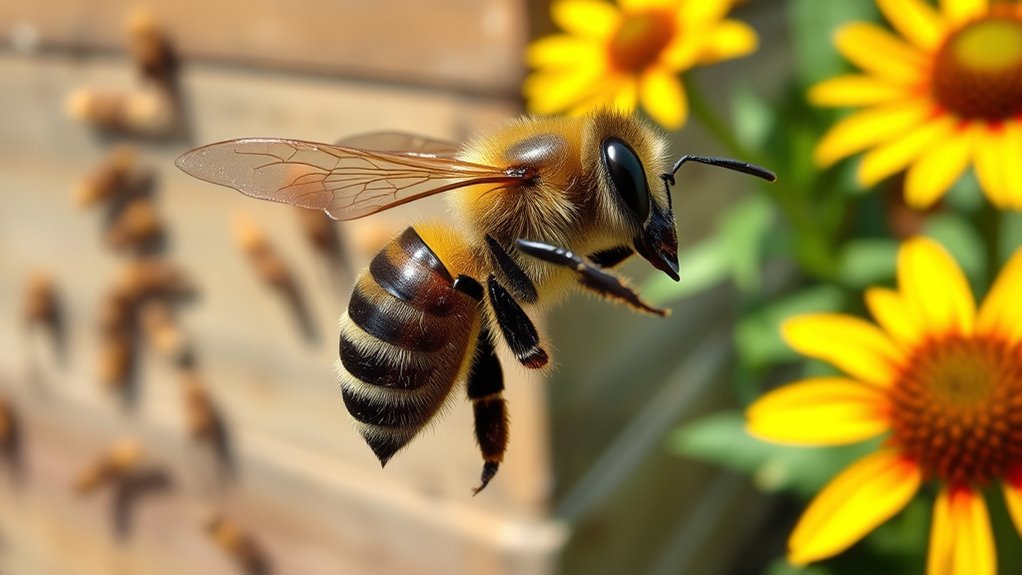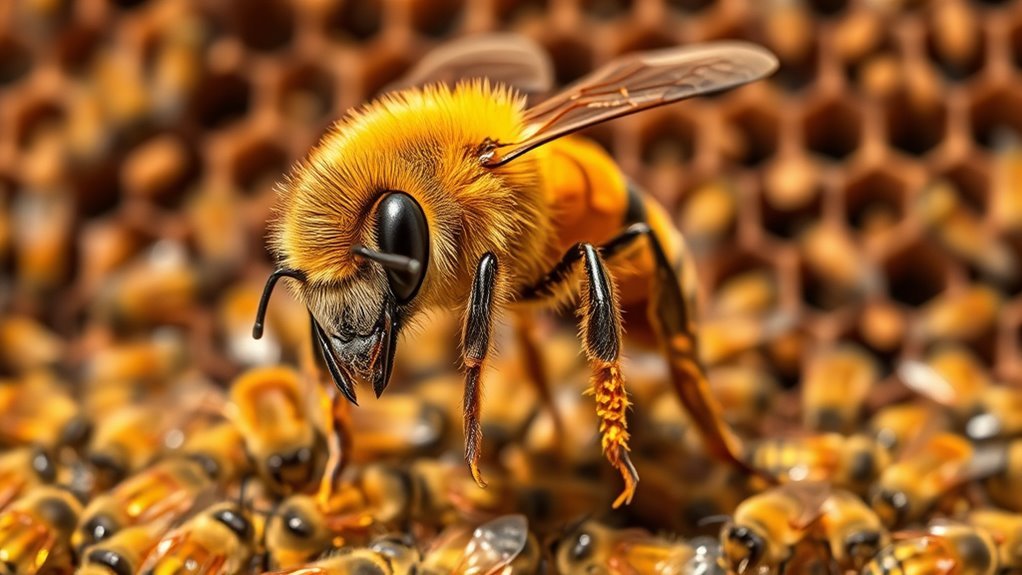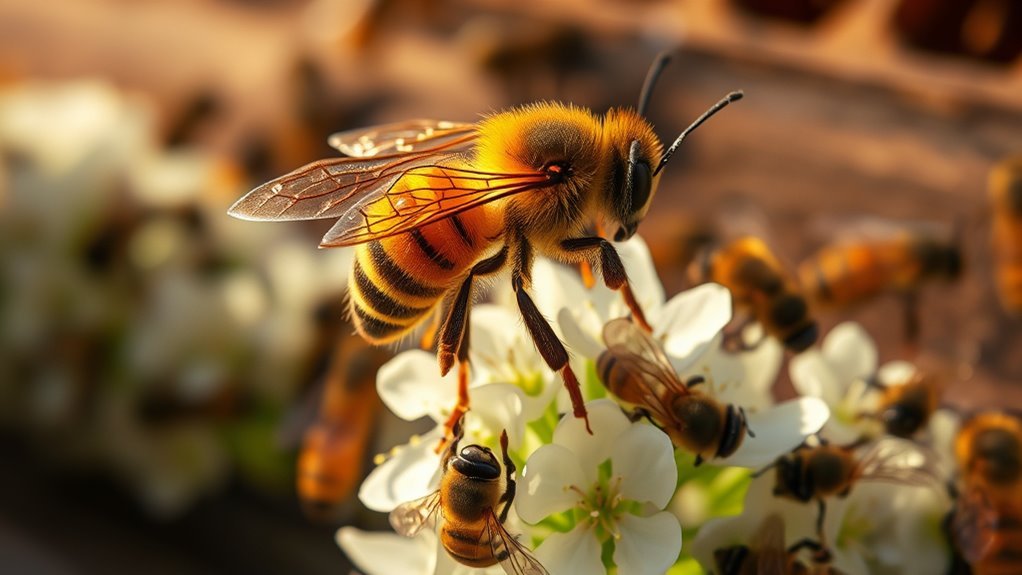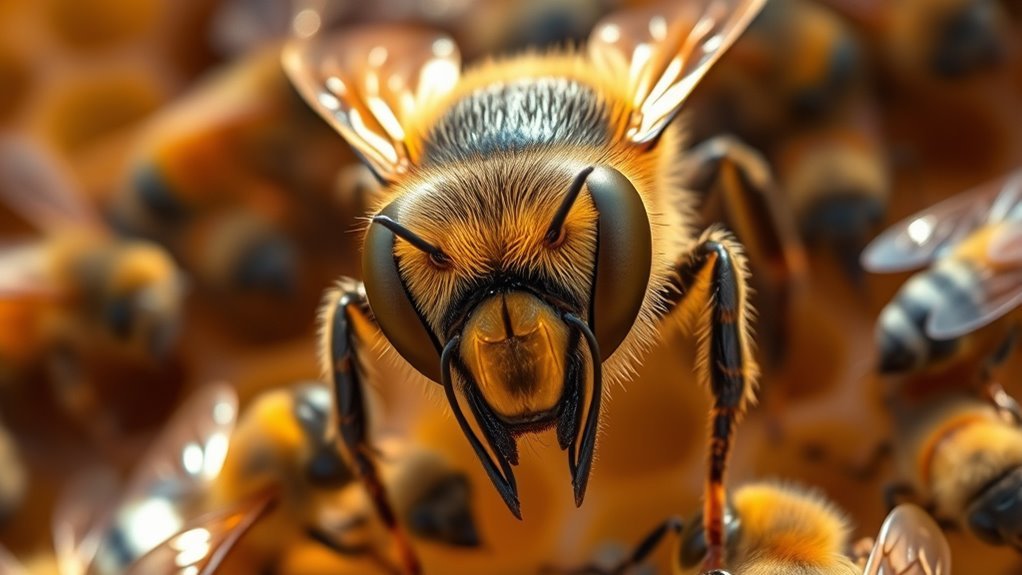You’ll find that drone bees primarily serve as the colony’s reproductive agents, mating with virgin queens to enhance genetic diversity and guarantee colony resilience. They have larger bodies and eyes optimized for high-speed flight and navigation during warm, sunny days when mating occurs. Drones develop from unfertilized eggs, and their population peaks seasonally before workers manage their care and, eventually, their removal. Understanding these roles reveals how drones support the colony’s survival and genetic health.
The Biology and Appearance of Drone Bees

Drone bees, the male members of the honeybee colony, have distinct biological characteristics that set them apart from worker and queen bees. When examining drone anatomy, you’ll notice their larger, more robust bodies designed primarily for reproduction, lacking the stinger found in females. Their eyes are noticeably larger, facilitating navigation during flight. Drone coloration tends to be darker and less patterned than worker bees, often exhibiting a uniform brown or black hue, which aids in quick identification within the hive. Unlike the more streamlined worker bees, drones have a bulkier thorax housing powerful flight muscles needed for mating flights. Understanding these precise anatomical features highlights the drone’s specialized role and evolutionary adaptations, granting them the freedom to fulfill their essential function without engaging in hive labor or defense.
The Mating Role of Drone Bees

Understanding the anatomy of drone bees provides insight into their primary function within the colony: reproduction. During the mating season, you observe drone bees preparing for drone flight, a critical activity where they leave the hive to seek virgin queens in nearby mating areas. This flight is energetically demanding and precisely timed, often occurring on warm, sunny days to maximize success. You’ll notice drones possess large eyes and robust thoraxes, adaptations that support high-speed flight and accurate navigation during these mating flights. Their sole biological imperative is to mate with a queen mid-air, delivering sperm necessary for colony propagation. Once mating occurs, the drone dies, emphasizing the high stakes of this reproductive role. You can appreciate how this specialized function guarantees genetic continuity while granting drones a brief yet essential freedom of flight.
How Drones Contribute to Colony Genetics

Although they live only briefly, drones play an essential role in shaping the genetic diversity of a honeybee colony. By mating with the queen during her nuptial flights, drones contribute unique genetic material, increasing allelic variation within the hive. This genetic diversity bolsters colony resilience, enabling adaptation to environmental stressors and disease resistance. Drone selection is a critical natural mechanism; only drones exhibiting ideal traits such as vitality and genetic compatibility successfully mate, ensuring the propagation of advantageous genes. As you understand the importance of this process, you recognize that drones are not mere passengers but active contributors to the colony’s genetic health. Their selective mating behavior supports the evolutionary fitness of the hive, ultimately sustaining a dynamic and robust colony capable of thriving independently.
The Lifecycle and Seasonal Behavior of Drones
While drones have a relatively short lifespan compared to worker bees, their development and activity follow a distinct seasonal pattern that aligns with the colony’s reproductive cycle. Understanding drone development and seasonal production is key to appreciating their role.
Drones live briefly but play a crucial seasonal role in the hive’s reproductive cycle.
- Emergence and Maturation: Drones develop from unfertilized eggs in drone cells, maturing over approximately 24 days before becoming sexually active.
- Seasonal Production Peaks: Drone production intensifies in spring and early summer, coinciding with prime mating conditions and queen fertility.
- End-of-Season Decline: As resources dwindle in late summer and fall, drones are often expelled from the hive to conserve energy, marking the end of their lifecycle.
The Relationship Between Drones and Worker Bees
The seasonal fluctuations in drone populations directly influence their interactions with worker bees, who manage many aspects of drone care and hive maintenance. Understanding drone behavior requires recognizing the worker hierarchy, where workers regulate feeding, grooming, and temperature control to optimize drone development. You’ll notice workers restrict drone access during resource scarcity, reflecting strategic colony management. This balance supports the colony’s freedom to allocate resources efficiently.
| Aspect | Emotional Insight |
|---|---|
| Drone Dependence | Vulnerability in reliance |
| Worker Care | Nurturing strength |
| Hierarchical Control | Structured freedom within order |
| Resource Allocation | Tough choices for survival |
| Seasonal Impact | Adaptation and resilience |
You see, the dynamic between drones and workers underscores collective survival and the delicate equilibrium sustaining colony freedom.

